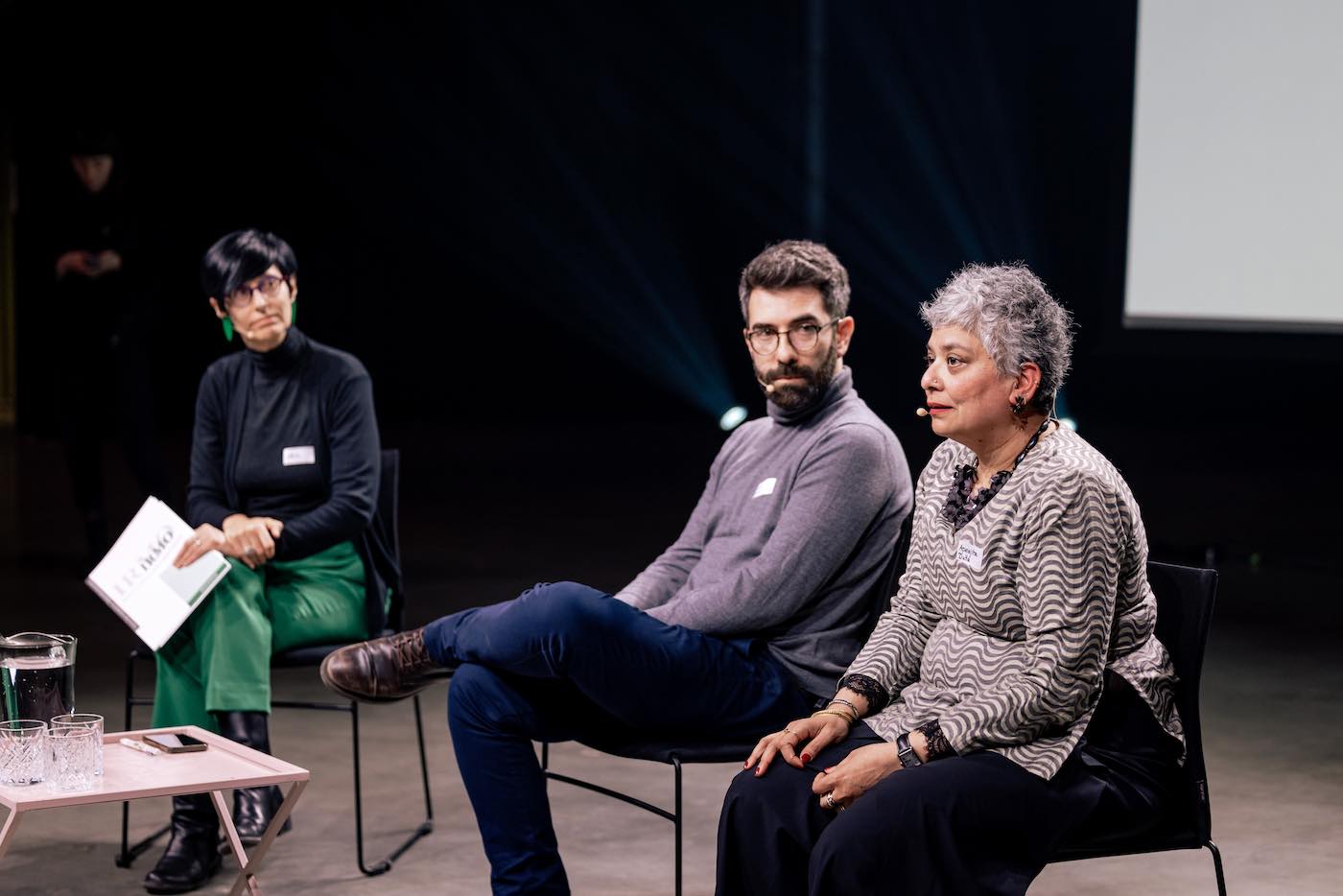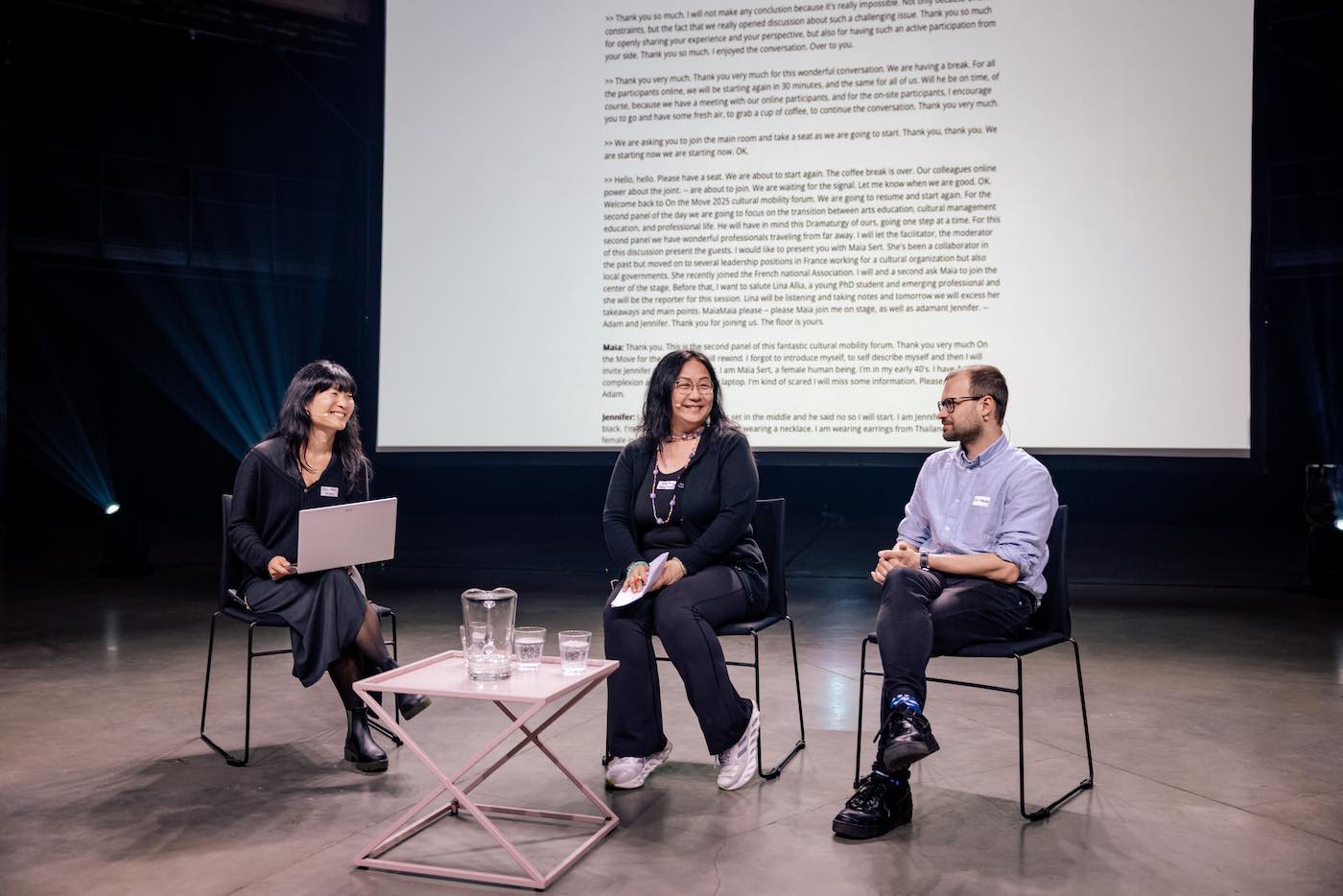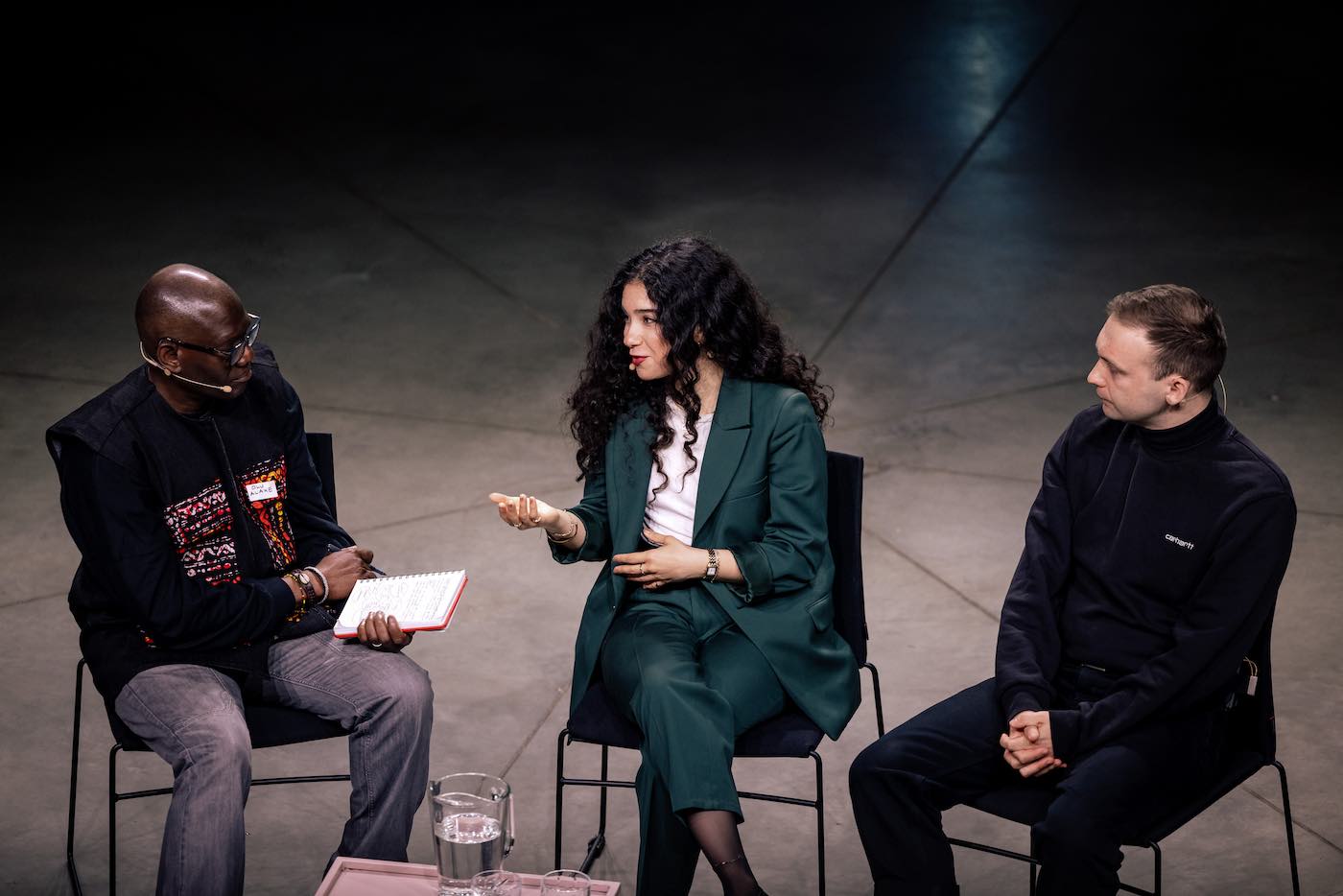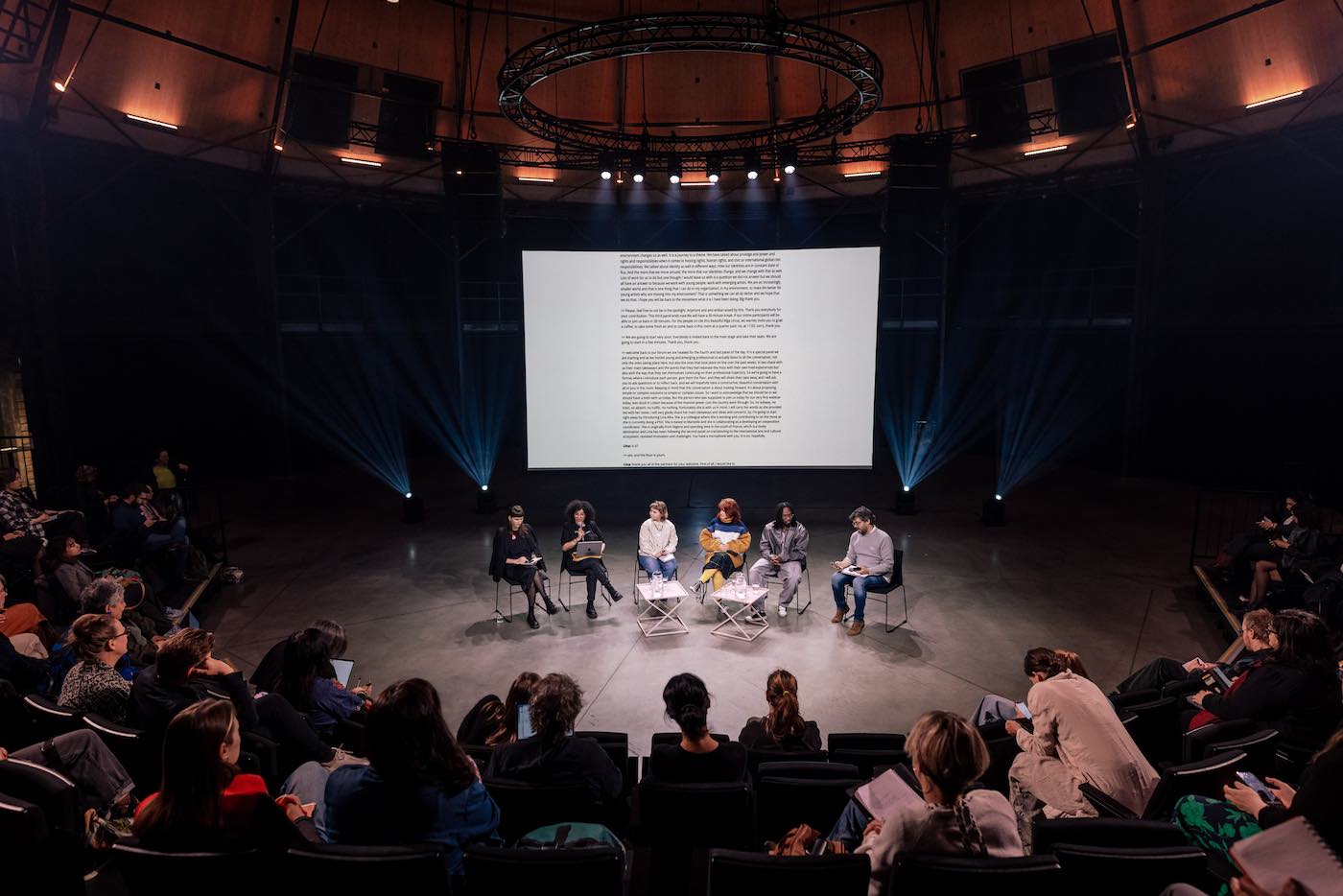This article was commissioned as an outcome of the Future Hospitalities hosted by On the Move member DutchCulture | TransArtists in Amsterdam, the Netherlands, and is part of their continuous efforts to support Ukrainian culture professionals and organisations with tailor-made visitor programmes focused on, for example, heritage protection, cultural policy, regional museums, or artist residencies (AiRs).
On the Move commissioned young art historian, independent curator, and researcher Alya Segal to follow the 2025 edition of the Cultural Mobility Forum and compose a blog article in Ukrainian and English. The goal is to circulate reflections and takeaways to young and emerging Ukrainian artists and culture professionals, and to maintain or start connections and exchanges with the next generation of creatives, particularly impacted by the war.
You can read this article in Ukrainian here.
On the Move is a platform for artists and cultural professionals that provides resources and expertise to help them reach the international level. Every year they organise the Cultural Mobility Forum to collectively explore international trends in artistic and cultural mobility. Previous forums covered topics such as digital mobility, environmental sustainability, and geopolitical inequality. This year, the fourth forum aimed to explore and rethink the experience of international mobility for artists and cultural workers whose practice began during the COVID-19 pandemic.
The focus of this year’s forum was on those professionals whose early career was spent in online education, virtual internships, and the inability to travel due to quarantine restrictions. My goal in this blog is to explore how the experience of the conference participants can be applied by the young generation of Ukrainian artists and cultural workers.
My own curatorial and research practice began six years ago, a year before the pandemic. Then, after the first realised projects, I decided to get an academic degree in art history. However, for me and my classmates, the opportunity to attend classes in person ended after the first semester. In spite of a number of challenges posed by online learning, its distance mode allowed me to start working at the Odessa Fine Arts Museum, where we tried to combine cultural activities with quarantine restrictions. At the beginning of 2022, the world began to recover from the pandemic, restoring the previous course of life, but in Ukraine, 2022 gave us an experience after which we began to remember the quarantine times as the last stable and happy ones. The war launched by Russia against Ukraine in 2014 and which escalated in 2022 has affected Ukrainians in all spheres of life. Many of my colleagues have lost their homes, relatives, health, or lives. Many of our friends, including those from the artistic community, have taken up arms and are defending us from Russian aggression on the battlefield. At the same time, we continue to work, showcase exhibitions, publish books, study (which, in my case, has been going on online for five years) and exchange experiences with colleagues from other countries.
Arts Education and Cultural Management Programmes: Embedding the Internationalisation of Practices
The first panel of the forum was dedicated to international programmes in educational institutions. The speakers were Paolo Montemurro, founder of Materahub, an organisation that supports the cultural and creative sector in Italy, and Aparajita Dutta, Head of International Relations at the University of the Arts in The Hague, the Netherlands. The conversation was moderated by Dr. Dea Vidovic.
Aparajita started the conversation by saying that the process of creating art is by its nature international. Since the beginning of the 2010s, the Royal Academy of Arts has moved from 80% of students from the Netherlands and only one English-language programme to 70% of students from abroad. This vector of internationalisation was accompanied by the professionalisation of the staff, mobility programmes (both sending students abroad and accepting foreigners to their own institution), and the requirement for programme participants to bring the experience gained to their own context.
Paolo also spoke about the importance for students to understand what kind of mobility will suit them in a particular period of their career and what they will bring back home (in contrast to focusing only on the experience that takes place during the mobility). The words of Paolo also resonated with me in that the experience of mobility can sometimes cause frustration: you go to a great place, see great practices and institutions, but you are not able to bring these experiences home. This is what I have experienced after attending professional visiting programmes in France, Germany, Denmark, and the Netherlands; many of the processes that were started in these countries 50–80 years ago were impossible in Ukraine under the USSR and most programmes that are being implemented in Western Europe today are determined by the economic situation of former empires, not former colonies. Being in this contrast of experiences is indeed frustrating, but it also encourages the borrowing experiences and the rethinking personal and institutional planning, and it provides a space for exchange about and criticism of Western institutions. Paolo also noted that for their organisation it is important that the experience of mobility is useful not only for the person who travels, but also for the host institution, as long as it is open to new experiences.

Aparajita continued this topic – she sees internationalisation not only as an experience of relocation, but also as an experience of communication. When we present our own practice to a foreigner, even in our hometown, we face the international experience. It is this interaction through alternative backgrounds and perspectives that can give our practices a new reading and depth. Art and cultural education, according to Aparajita, remains a deeply privileged field. Out of the 4,000 applications that their institution receives, only 600 are selected. She also emphasised the mismatch in student selection at institutions that simultaneously seek to accept the best of the best but also be accessible and inclusive. Aparajita does not see this system being willing to change and reconcile these aspirations. According to Paolo, mobility programmes are becoming more accessible thanks to their visibility, additional funding opportunities for participants with special needs, and openness to such applications within institutions. A member of the audience, Bojana Panevska, President of On the Move, also added that mobility and university study opportunities (including tuition fees) differ for students from Europe, EU member states, and students coming from outside Europe.
Moving back to the Ukrainian context, we have to make a few important remarks. For many Ukrainian students, mobility programmes in 2022 became an opportunity to escape the war but continue their professional path. Some of them decided to stay in the country of residence because they could not return to the dangerous region of Ukraine, while others decided to return and continue their careers at home. However, I would also like to draw attention to the category of students who are currently unable to travel abroad: those who are obliged to serve in the military and those who are active military members (mostly men, but also women). For this category of students or applicants, the opportunities offered by Europe are often unavailable. The ability of Ukrainian universities to accept exchange students is also currently limited due to security conditions. At the same time, the Ukrainian community is adapting to the current conditions and continues to develop. Therefore, education programmes that allow you to expand your own practice and give impetus to professional development can be a good alternative for those who want to develop in this direction.
Transitioning to the International Arts and Culture Ecosystem: Revisited Motivations and Challenges
The second panel of the forum covered the period of formation of young professionals after graduation, as well as the issues of competitive environment and motivation. The panel featured Adam Svoboda from the Prague Quadrennial (Czech Republic) and Jennifer Lee from the Mekong Cultural Hub (Taiwan), moderated by Maïa Sert.
Jennifer shared the story of her own professional path. While working in the theatre sector in Taiwan, she realised at some point that ‘international’ does not really cover all countries. This realisation sooner or later catches up with all cultural workers who do not come from Western Europe. Continuing the theme of the previous panel, Adam drew an analogy between the Erasmus programme and the broader geopolitical context in which artists are often unable to participate in professional events, whether due to lack of funding, visa restrictions or war. Both the Prague Quadrennial (PQ) and the Mekong Cultural Hub discussed these different experiences and ways to bridge the gap between participants.
Jennifer observed, drawing from her own experience and the experience of her organisation, that an important aspect of their practice is to constantly rethink the vocabulary and ask what seem to be simple questions, such as: ‘Does something really work this way, or are we just used to the way things are?’ Her own interest in working with diverse people and communities led her to the Mekong Cultural Hub, where she continues to cultivate a sense of conscious unknowing from which empathy and new approaches are born.
Adam Svoboda began his journey with PQ in 2011, and with each new edition he has worked more tightly with the institution. PQ is a significant event in the cultural life of the city, which has been taking place for almost 60 years. The PQ programme consists of exhibitions of regions and countries, as well as a student exhibition. The Czech Ministries of Culture and Foreign Affairs send official requests to the participating countries, who each send selected representatives through an internal open call. The rest of the PQ is curated by an international team, where each curator is responsible for their own section.

The Mekong Cultural Hub has its own international relations support programme aimed at bringing professionals to Southeast Asia, as well as supporting the exchange of artists within the region. The organisation focuses on emerging practitioners working at the intersection of art, culture and society and changing the status quo through their work. They have a scholarship that is aimed at networking and knowledge exchange between participants from different regions. The programme also analyses the needs of the participants and adjusts support to cater for specific requests. Cooperation with grassroots initiatives is an important focus area and diversity is a key criterion in the organisation’s work; the latter is difficult to implement, but, according to Jennifer, diversity creates conditions for new ways of collaboration. She also noted that participants often need new networking and community rather than financial support.
Community building is also a key aspect of PQ. According to Adam, networking and communication have always been a part of the quadrennial, but not part of the official programme. The next edition of PQ aims to change that and focus on young professionals and students. The goal is not only to allow this category to participate in the general panels, but also to give them a voice. After all, beginners often have a lot to say and to bring to the industry.
The discussion also touched on the topic of language. Today, English is the international language of communication, but participation in events is often a privilege. Many cultural workers, especially the older generation, have communication difficulties due to the language barrier. At the same time, the example of PQ shows that simultaneous interpretation in several languages is not always possible due to limited budgets. Adam hopes that with the development of technology, simultaneous interpretation will become faster, more convenient, and less resource intensive. Jennifer also emphasised the role of mediators – people-bridges who are able to transfer knowledge and establish connections between different communities and contexts.
In the Ukrainian context, the language aspect and the lack of access to mobility are also important. Today, artists who participate in mobility programmes, who study abroad, or who create exhibitions in Europe become mediators between the inner and outer world when they return to Ukraine. The exchange of experience takes place through personal conversations, professional panels, and critical essays. Such communication requires effort from both the ‘travellers’ and those who stayed at home, as those at home are also encouraged to go beyond the national context and look at the wider cultural field.
Points of Departure, Points of Arrival: Young Arts Workers Reviewing International Relations
The panel featured Niusha Khanmohammadi and Bahdan Khmialnitski and was moderated by Olu Alake. This discussion was dedicated to the experience of beginners in an international context, particularly in the context of migration. Niusha was born in Sweden and has Iranian origin, but has lived and worked in many countries throughout her career before returning to Sweden. Bahdan was born and raised in Belarus, but after the revolution of 2020 and the suppression of the protest movement by the Lukashenko regime, he went to the UK to study, before later living in Georgia, where he worked at the Goethe Institute, and then moving again to live in Lithuania.
Speaking about changing his place of residence, Bahdan emphasised the impossibility of developing his own practice in a sustainable way: ‘Traveling to a new context is like you are an emerging artist again. You have to establish a network or you should use the most of what you already achieved and gained.’ Niusha also noted the importance of distinguishing between the terms ‘emerging’ and ‘young’. Often, the beginning of a career is associated with a young age, but a professional path can begin at any age, either after a change of field of activity or a change of context or place of residence.

Bahdan explains that ‘Home is now linked to memories and to pain, but also to some power, I would say…The thing is that home is not something very stable, and it can change’. He also noted that the sense of home is re-established through connections with the diaspora and local communities, including the queer community. Niusha said that Sweden, where she was born, never felt like home to her emotionally. As an ethnic Iranian, she was visually different from her surroundings, but as a ‘right’ immigrant, she did not feel fully connected to her roots. Her sense of home came years later, after several relocations, in Istanbul, a city that accepted and supported her fully.
Responding to a question from panel moderator Olu Alake about cultural diplomacy, Bahdan shared his own experience in which his path to culture began after studying international law. According to him, diplomacy, in particular cultural diplomacy, is not something abstract or exclusively institutional, but also about personal connections and role models that we form and implement. These words resonate deeply with my experience – every time I cross the Ukrainian-Polish border (which is now the main path to Europe and takes at least a 24-hour journey from Kyiv), I automatically become a representative of a country that is resisting brutal military aggression. My colleagues may have different levels of awareness of the situation in Ukraine, but personal communication always has a deeper impact. Often I feel that through my personal stories and the stories of my friends that I bring with me, my new friends develop what may be their first real contact with my homeland.
Takeaways and Recommendations
The last panel was dedicated to the young cultural workers who attended the forum to share their findings. The panel was moderated by Johann Floch from On the Move.
Lina Allia from Algeria, who is currently studying in the south of France, highlighted the most resonant moments of the second panel:
- the large number of programmes presented that bridge the gap in age, competence, potential, and between centres and margins;
- the importance of the questions that Jennifer Lee uses in her practice: ‘Why are we doing this?’, ‘Who are we doing this for?’ and ‘What are we fighting for?’
- the need to not start anew every time, destroying the previous one, but to work with the existing state of affairs;
- the idea that in a world of constant conflict, we have no right to look away to feel comfortable.
Andrew Ogun from the United Kingdom, who also attended the pre-forum webinars, noted the following points:
- the role and responsibility of organisations and institutions in global mobility processes – they should be patrons, provide a platform, and systematise information;
- the world is changing faster and faster – COVID-19, the spread of artificial intelligence, changes in the socio-economic context;
- the artistic community must constantly question the current state of affairs, ask questions, and explore its own identity;
- long-term planning is being replaced by short-term projects, but the need for visionary and strategic thinking for 5, 10, and 20 years is only growing;
- residencies, especially hybrid and online ones, are gaining popularity and the importance of multimedia in artistic practice is also growing.
Ikars Grasdanovičs from Latvia shared her impressions of the first panel:
- there is a tendency to implement international programmes yet at the same time, the world is becoming smaller and closer;
- young people are not always ready for risky career decisions, but planning and a pragmatic approach can help;
- the universality of English is a tool, but also a barrier for those who do not speak it.

Karu Treij from Latvia, who attended the third panel, noted:
- theoretical accessibility of mobility (strong passport, financial capabilities) does not guarantee actual participation, the key is to disseminate information to the target audience;
- mobility is often accompanied by discomfort, but international events can take place in the participant’s country of residence, which simplifies access to experiences;
- what professionals can do for young actors is to trust, support and allow them to make mistakes.
Clara Passarinho from Portugal, who attended the webinar on opportunities for young and emerging artists, highlighted that:
- the term ‘beginner’ does not refer to age, but to the phase of professional development;
- international opportunities are more often available to those who are already recognised at the national level;
- financial and geopolitical factors have a significant impact on the accessibility of programmes, especially for representatives of ‘closed’ regions;
- programmes should be adapted to different artistic disciplines and career paths;
- in addition to financial support, platforms for expression, dialog with curators and exchange with colleagues are extremely important;
- participation in cultural mobility programmes has a long-term effect and opens up new opportunities.
Katrīna Dūka from Latvia, who has extensive experience in international cooperation, highlighted:
- motivation for mobility is essential not only for applicants, but also for host institutions, which should provide mentoring and space for exchange;
- long-term support for artists is crucial, not just support for short-term projects.
Conclusions for the Ukrainian community
In times of extreme turbulence, cultural mobility seems to be a difficult and even secondary task. Protecting one’s own context – particularly in times of war – naturally comes to the centre stage. However, self-isolation and focusing only on the domestic, is not a sustainable strategy in the long run. Russia’s full-scale invasion has brought not only pain and loss, but also increased attention to Ukraine, to our resistance, and to our culture. European partners want to hear us, support Ukrainian initiatives, and create new common narratives. Whether we take advantage of this window of opportunity is up to us.
Advice and conclusions should be adapted to different groups within the Ukrainian cultural community. For those who have the opportunity to travel, participate in international programmes, and return home, it is especially important to realise their role as mediators. We become carriers of experience, representatives of Ukrainian culture in the world, and at the same time ‘bridges’ to the international environment for those who are forced to stay. Such mobility should not be an escape, on the contrary, it can and should become a strategic investment in the Ukrainian context. The experience brought from outside is not just an example of ‘how it should be,’ but a resource for critical dialogue and transformation. Today, there are more opportunities than ever to participate in residencies, training programmes, grants, and institutional partnerships. It is worth remembering this privilege and sharing the gained knowledge with those who are temporarily forced to put their practice on hold to protect the country.
For those who remain in Ukraine, whether at home or at the front, it is important to remember that international presence is not limited to physical mobility. It is possible to be visible in the global context through other forms of interaction: online programmes, remote residencies, and cooperation with those who come to Ukraine. Your artistic practices, research, texts, or works can become intermediaries that translate our experience to an international audience. The pandemic crisis has left us with a valuable legacy in that it has provided flexible digital formats that can work for our visibility and inclusion today, in times of war. Mobility is not only about movement, but also about the ability to be heard, seen, and included in the global cultural dialogue.
